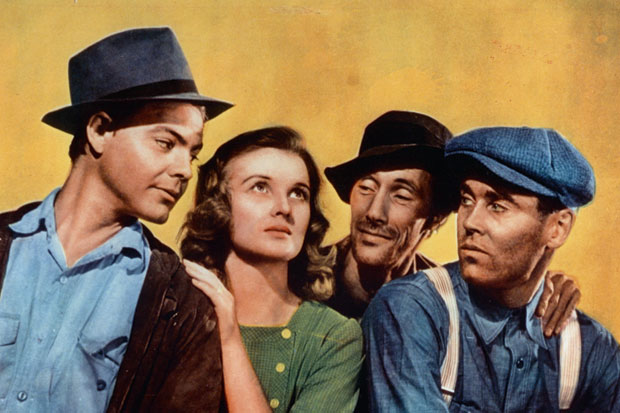John Steinbeck (1902–1968), an ardent propagandist for the exploited underdogs of the Great Depression, had barely enough money for subsistence during the years he spent preparing and writing The Grapes of Wrath, the protest novel regarded as his masterpiece. It made him a Nobel laureate and a very rich man. The Nobel committee praised his ‘realistic and imaginative writing, combining . . . sympathetic humour and keen social perception’. Seventy-four years after first publication, the book still sells more than 100,000 copies a year.
In his Nobel acceptance speech in 1962, Steinbeck said that ‘a writer who does not passionately believe in the perfectibility of man has no dedication nor any membership in literature’. Many a laureate has declared such a lofty credo, but Steinbeck seems really to have lived by his words, especially in the important early years of his career. When he wrote the grim saga of the Joad family of Oklahoma sharecroppers displaced by crop failure and bank foreclosure, and their gruelling trek to the inhospitable paradise of California, he was writing a controversial left-wing manifesto calling for welfare beyond Roosevelt’s New Deal. The responses ranged from popular and critical acclaim to institutional book-burning.
Susan Shillinglaw’s unflinchingly candid portrait of Steinbeck’s marriage to Carol Henning, his first, from 1930 to 1943, is an intimate anatomy of a muse and her inspirational insistence on the consummation of authorship. Shillinglaw has devoted much of her adult life to Steinbeck studies, most notably having directed San José State’s Steinbeck Center and edited the Steinbeck Newsletter. She has used innumerable interviews and previously undisclosed archival material, including letters and scrapbooks, to enable this excellent double biography to reveal her subjects’ innermost virtues and faults, while she always remains equally sympathetic to both parties — a difficult balancing act.
Carol and John met when she was 22 and he was 26, when she was on holiday and he was working as the custodian of a fish hatchery on the California shore of Lake Tahoe. It was love at first sight, and his calling himself ‘a piscatorial obstetrician’ appealed to her sense of humour. As well as being an earnest radical idealist, she was a sardonic wit. Typically, she wrote verses in the style of Dorothy Parker: every conventional sentiment was subverted by a last-line cynical zinger.
Furthermore, Carol was a strong, handsome, uninhibited woman, eager to advance Steinbeck’s art in humanitarian causes. As Shillinglaw says of her influence:
From the first weeks she and John were together, she was intellectually and emotionally bound to him. Like countless women before and since, she threw her own intelligence and considerable energies into her mate’s endeavours.
Even further left politically than John, she galvanised his assault against the big farmers and banks that evicted the sharecroppers from their land and cruelly underpaid them when they begged for work in California. Carol strengthened John’s determination to understand the migrant labourers by working with them in the orchards and cotton fields and then to record faithfully their peculiar dialogue, writing and rewriting countless drafts — which she typed. She even gave John the titles for his best two novels, Of Mice and Men from Robert Burns and The Grapes of Wrath from ‘The Battle Hymn of the Republic.’
Carol’s creative drive was fully complemented by John’s. He was a writer of fierce talent and industry. According to Carol’s sister Idell, John was ‘erotic, violent, passionate, stimulating’. Together, Carol and he were able to endure years of hard work in intermittent poverty. Their natural gregariousness was fortified by vast quantities of local red wine. In his room at Stanford University, where he spent five years reading literature without earning a degree, John, having devolved from Episcopalian to agnostic, set up an altar to a celluloid kewpie doll he called ‘The Goddess of Chastity’, which was never a handicap. In spite of his empathy with the wretched have-nots of America, he allowed himself occasions of frivolity. As well as writing about Woody Guthrie, ‘the Dust Bowl Troubadour’, he published essays on Gypsy Rose Lee, Eddie Condon, Bob Hope and Al Capp, creator of the comic-strip hero Li’l Abner.
Some contemporaries described John’s eclecticism as plagiarism. Carol dubbed him ‘a lint picker’ and F. Scott Fitzgerald called him ‘a cagey cribber’. John referred to himself as ‘a shameless magpie’. He said he admired Hemingway’s short stories and nearly everything Faulkner wrote, but believed that he himself was inspired by more than individuals. He felt that his work was bigger than he was, derived, perhaps, from Jungian folk memories.
In The Grapes of Wrath the Preacher says: ‘Maybe all men got one big soul ever’body’s a part of.’ For Carol and John, the term for ‘the deepest sources of meaning’ was the phalanx. It encompassed all underlying philosophy and all their most supportive friends, particularly Edward Ricketts, the marine biologist. After the triumphant publication of The Grapes of Wrath, Shillinglaw sadly notes, the phalanx fell apart, Carol and John divorced, and none of his later novels was as good.






Comments